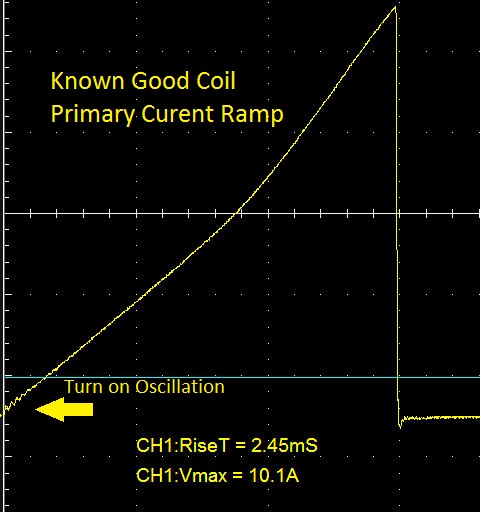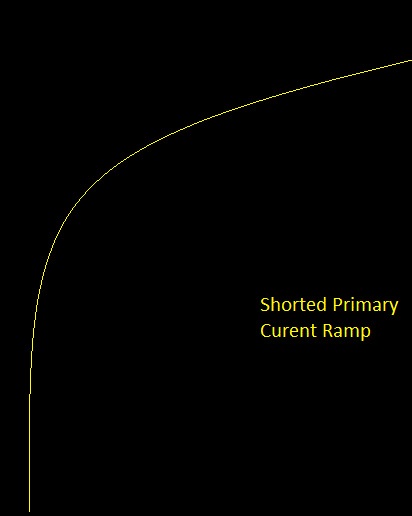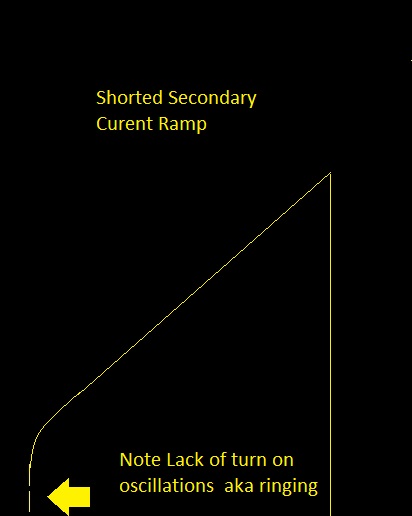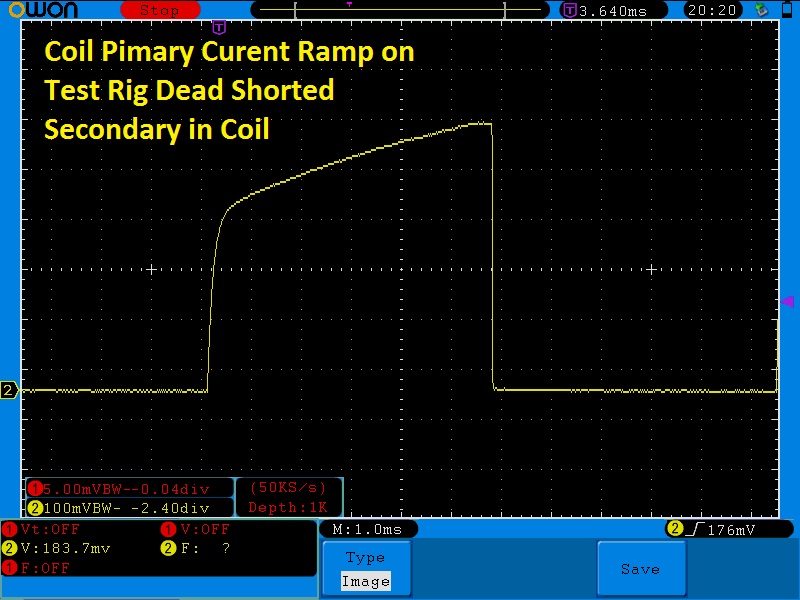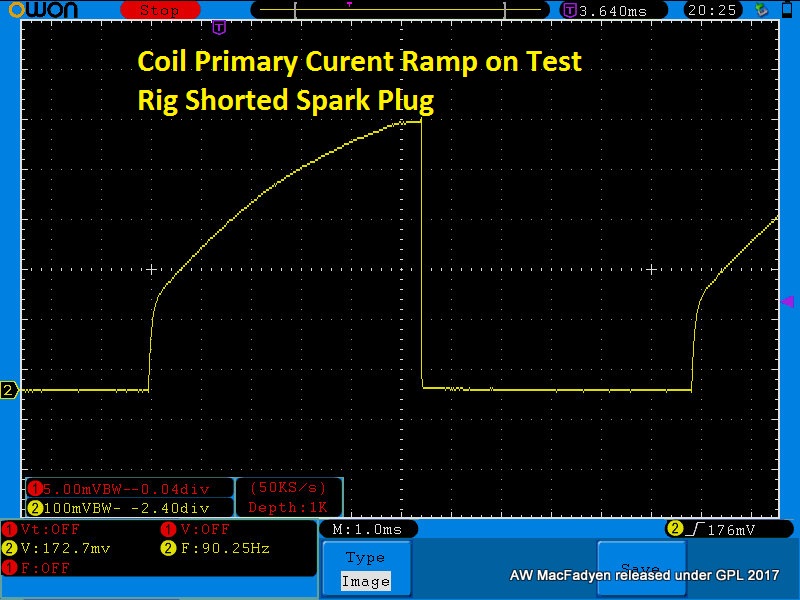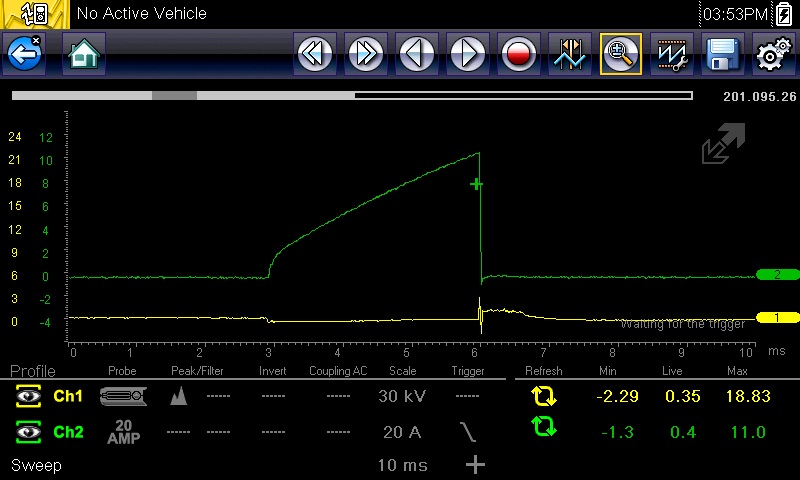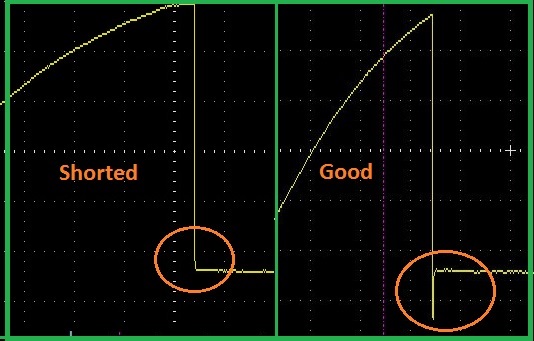*** Restricting New Posts to SD Premium Members ONLY *** (09 May 2025)
Just made a new account? Can't post? Click above.
How to find a shorted coil on a Ford 5.4 engine (misfire diagnosis)
- ecwurban
-
 Topic Author
Topic Author
- Offline
- Premium Member
-

- Posts: 125
- Thank you received: 25
So my question is in the video you call it shorted secondary. Wouldn't that pattern purely be from a shorted primary? It shoots straight up without having any kind of ramp until almost the end. And to compensate for the lowered resistance it has like a third the dwell time as all the others.
The reason for my question is imagine this wasn't a COP. If it were a secondary issue you'd still have to rule out the plug wire and the plug. On some vehicles that can be a chore. Whereas with this pattern, with its straight vertical lines and narrow dwell, if that can only be attributed to shorted primary then you'd be done as soon as you saw that pattern. You wouldn't have to look at anything else to know that the coil is the issue.
And, yes, I know everything effects everything else. And you still want to check other things to make sure there wasn't some root problem that's just going to burn that new coil up again. But in that case I would just pop a coil in and recheck it. Make sure the ignition pattern looked good and it wasn't running lean.
But ya, I'm trying to reduce the second guessing and the feeling of being obligated to do follow up tests that can introduce new ambiguities.
Please Log in or Create an account to join the conversation.
- Andy.MacFadyen
-

- Offline
- Moderator
-

- Posts: 3353
- Thank you received: 1037
" We're trying to plug a hole in the universe, what are you doing ?. "
(Walter Bishop Fringe TV show)
Please Log in or Create an account to join the conversation.
- ecwurban
-
 Topic Author
Topic Author
- Offline
- Premium Member
-

- Posts: 125
- Thank you received: 25
Secondary ignition is one area I need to spend a lot more time researching for sure.
Please Log in or Create an account to join the conversation.
- Andy.MacFadyen
-

- Offline
- Moderator
-

- Posts: 3353
- Thank you received: 1037
Theses days every ignition system is different particularly all the different types of coil COP system, how do you know what is normal? and with COP systems even getting a secondary voltage trace can be difficult and with 3 and 4 wire COP looking primary voltage is impossible.
I haven't encountered this myself yet but IST Paul has at least one video where an aftermarket 3 wire (might be 4 wire) coil has a completely different curent draw on the control wire from the OEM part, istr Paul's brother James also has a video showing aftermarket COP with different secondary characteristics from the OEM and the issue was also raised on the forum a couple of months back.
At the end of the day you check if the coil is getting power and control if it passes that and is easy to access you simply go old school and swap it to another cylinder to see if the fault follows the coil. If it is on the rear bank of a V6 and have had to do major work to access it you replace the coil with known good and also the spark plug. Examining the spark plug that comes out is important, although modern ignition system can provide a lot more energy than the systems of 40 years ago and modern platinum or irridum spark plugs should last for interstellar mileages but a damaged, cracked or worn out spark plug can not only cause a misfire but drive the voltage demand on the spark plug so high the insulation of the coil is destroyed.
The primary is a reflection of the secondary and vice versa but the real give away for a shorted secondary in the turn on oscillation, if the secondary is shorted the turn on oscillation in the primary gets instantly snuffed out.
But if you see a vertical or very near vertical rise at coil turn on then the coil primary is shorted
Thisillustrates a shorted secondary
" We're trying to plug a hole in the universe, what are you doing ?. "
(Walter Bishop Fringe TV show)
Please Log in or Create an account to join the conversation.
- ecwurban
-
 Topic Author
Topic Author
- Offline
- Premium Member
-

- Posts: 125
- Thank you received: 25
If that diagram is correct then you should have continuity between the high tension side and the positive terminal of the primary. Electricity has to go back to its source. So I would think a simple COP design should have to be that top married style. Whereas a waste spark or a system that has two plugs per cylinder could use the separated style. Or if one uses an extra ground wire for completing the secondary circuit. Although I'm not sure I've seen that..? I haven't seen any coils that were case grounded and if it had a separate wire then that wire would have crazy high EMI so I don't imagine it would be placed with the regular harness..?
If the secondary winding is electrically separate from the primary I wouldn't think a shorted secondary would have much effect on the primary current during saturation. Other than details like turn on oscillations. You wouldn't have the secondary pumping counter voltage back into the primary via mutual induction but the primary would still have its own counter voltage from self induction. I would have thought that, if they are non connected windings, that it should still have a ramp just like a fuel injector or any other solenoid that only has a primary winding. Going by this line of thinking that would mean that a shorted secondary would show a similar current pattern to an open secondary. Which would be very easy to test. I think I'm off to the junk yard to grab some spare parts for my car to do some captures of introducing known faults...
Secondary totally is a lost art. Which is too bad really. A lot of vehicles still have leads even if they have their own coils. I think part of the issue is the old analyzers would do most of the work for you. You just make all the connections, enter the number of cylinders, etc and the machine would give you a nice parade. Whereas now you'd have to set up the scope, put your own trigger, adjust scales, etc and do one at a time so you can't really get the comparisons as easy.
Thanks for all the info. I shall take it all under consideration and do some more research!
Please Log in or Create an account to join the conversation.
- Andy.MacFadyen
-

- Offline
- Moderator
-

- Posts: 3353
- Thank you received: 1037
The results were very clear cut and very interesting.
" We're trying to plug a hole in the universe, what are you doing ?. "
(Walter Bishop Fringe TV show)
Please Log in or Create an account to join the conversation.
- Tyler
-

- Offline
- Moderator
-

- Full time HACK since 2012
- Posts: 6052
- Thank you received: 1523
Please Log in or Create an account to join the conversation.
- ecwurban
-
 Topic Author
Topic Author
- Offline
- Premium Member
-

- Posts: 125
- Thank you received: 25
Please Log in or Create an account to join the conversation.
- Andy.MacFadyen
-

- Offline
- Moderator
-

- Posts: 3353
- Thank you received: 1037
" We're trying to plug a hole in the universe, what are you doing ?. "
(Walter Bishop Fringe TV show)
Please Log in or Create an account to join the conversation.
- Andy.MacFadyen
-

- Offline
- Moderator
-

- Posts: 3353
- Thank you received: 1037
(1) It will only show a fail if there is a dead short, not an arcing short.
(2) It won't work on a shared coil if only one the half of the secondary circuit is shorted.
(3) On a DIS system because of spark gap between the rotor arm and the segment in the cap it will only produce a result if the coil has an internal short, any shorts outside the coil (eg a smashed spark plug) won't show up.
(4) For shorts outside the coil (trace A) eg. a smashed plug the resistance of the plug lead reduces height of the signature vertical rise compared to an internal short in the coil (trace B )
" We're trying to plug a hole in the universe, what are you doing ?. "
(Walter Bishop Fringe TV show)
Please Log in or Create an account to join the conversation.
- Tyler
-

- Offline
- Moderator
-

- Full time HACK since 2012
- Posts: 6052
- Thank you received: 1523
ecwurban wrote: Wow, that is interesting. I didn't think a secondary issue would show so much in primary current. Especially in the beginning when it's just starting to build a magnetic field.
I was surprised, too! When I took that waveform, I mostly just wanted to see control and good current flow. Finding the short definitely helped fast track that diagnosis.
Please Log in or Create an account to join the conversation.
- Andy.MacFadyen
-

- Offline
- Moderator
-

- Posts: 3353
- Thank you received: 1037
Once you know what to look for it is a pretty useful indicator of a dead short on the high tension (secondary) side of the ignition, but it seems is not valid for a sparking short which is probably the most common COP failure mode.
With a COP system especially the 3 and 4 wire types current ramping is now going to be my first line of attack after looking at the misfire counters rather than going straight in with a paddle probe
" We're trying to plug a hole in the universe, what are you doing ?. "
(Walter Bishop Fringe TV show)
Please Log in or Create an account to join the conversation.
- ScannerDanner
-

- Offline
- Administrator
-

- Religion says do, Jesus says done!
- Posts: 961
- Thank you received: 499
Don't be a parts changer!
Please Log in or Create an account to join the conversation.

